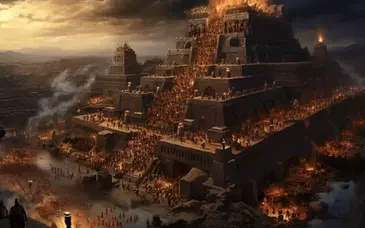The Destruction And Transformation Of Indian Societies
The various Indian peoples responded in many ways to the invasion of
America and the transformation of their societies. All of them suffered a
severe decline of population. This was a demographic catastrophe of incredible
proportions. On the main islands of the Caribbean, the Indian population had
virtually disappeared by 1540, a result of slaving, mistreatment, and disease.
In central Mexico, war, destruction, and above all disease brought the
population from an estimated 25 million in 1519 to less than two million in
1580. In Peru, a similar process brought a loss from 10 million to 1.5 million
between 1530 and 1590. Elsewhere in the Americas a similar but less
well-documented process took place. Smallpox, influenza, and even measles
wreaked havoc on the Indian population, which had developed no immunities
against these diseases.
While epidemic disease was the major cause of depopulation, the
destruction of the conquest and the weakening of indigenous societies
contributed to the mortality and made the Indian populations more susceptible
to disease. Population losses of this size disrupted Indian societies in many
ways. For example, in central Mexico the contraction of the Indian population
led the Spanish to concentrate the remaining population in fewer towns, and
this led in turn to the seizure of former communal farming lands by Spanish
landowners. Demographic collapse made the maintenance of traditional social
and economic structures very difficult.
The case of Mexico is particularly stark. The tremendous decline of the
Indian population was matched by the rapid increase in European livestock.
Cattle, sheep, and horses flourished on the newly created Spanish farms or on
unclaimed lands. In a way, the Indian population of Mexico was replaced by
European livestock.
Exploitation Of The Indians
Spanish desires to exploit the Indians as laborers or to extract a
tribute from them led to Spanish attempts to maintain those aspects of Indian
life that served colonial goals or at least did not openly conflict with
Spanish authority or religion. Thus, in Mexico and Peru, while the old Indian
religion and its priestly class were eliminated, the traditional Indian
nobility remained in place, supported by Spanish authority, as middlemen
between the tax and labor demands of the new rulers and the majority of the
population.
The enslavement of Indians, except those taken in war, was prohibited by
the mid-16th century in most of Spanish America. Instead, different forms of
labor or taxation were imposed. At first, encomiendas were given to the
individual conquerors of a region. The holders of these grants, or
encomenderos, were able to use their Indians as workers and servants or to tax
them. While in the Inca and Aztec empires commoners had owed tribute or labor
to the state, the new demands were arbitrary, often excessive, and usually
devoid of the reciprocity of obligation and protection characteristic of the
Indian societies. Encomiendas were introduced after the initial conquest of a
region from New Mexico in the north to Chile in the south. In general, the
encomiendas proved to be destructive to Indian societies, and as depopulation
continued, the holders of the grants became dissatisfied. Finally, the Spanish
crown, unwilling to see a new nobility arise in the New World among the
conquerors with their grants of Indian serfs, moved to end the institution in
the 1540s. The crown limited the inheritability of encomiendas and prohibited
the right to demand certain kinds of labor from the Indians. While encomiendas
continued to exist in marginal regions at the fringes of the empire, in the
central areas of Mexico and Peru they were all but gone by the 1620s. With the
disappearance of the encomienda, the colonists and descendants of the
conquerors increasingly sought grants of land rather than Indians as the basis
of wealth.
Meanwhile, the colonial government increasingly extracted Indian labor
and tax through local royal officials. In many places, communities were
required to send groups of laborers to work on state projects, such as church
construction or road building, or in labor gangs for mining or agriculture.
This forced labor, called the mita in Peru, mobilized thousands of Indians to
work in the mines and on other projects. While the Indians were paid a wage
for this work, there were many abuses of the system by the local officials,
and community labor requirements were often disruptive and destructive to
Indian life. By the 17th century, many Indians left their villages to avoid
the labor and tax obligations, preferring instead to work for Spanish
landowners or to seek employment in the cities. This process eventually led to
the growth of a wage labor system in which Indians, no longer resident in
their villages, worked for wages on Spanish-owned mines and farms or in the
cities.
In the wake of this disruption, Indian culture also demonstrated
considerable resiliency in the face of Spanish institutions and forms,
adapting and modifying them to Indian ways. In New Spain, the Spanish
municipal councils established in Indian towns were staffed by the Indian
elite, and their operations reflected pre-conquest patterns within European
forms. In Peru and Mexico, Indians learned to use the legal system and the law
courts so that litigation became a way of life. At the local level, many
aspects of Indian life remained, and Indians proved to be selective in their
adaptation of European foods, technology, and culture.

